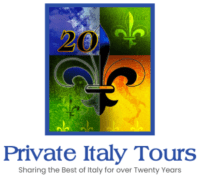A mere eleven miles from the city center of Florence lies one of the most beautiful of the many Medici villas which dot the Tuscan countryside. Lorenzo de Medici, known as “The Magnificent” oversaw the construction one such location: the villa Poggio a Caiano. The approach to the villa offers a spectacular view, showcasing a balanced twin staircase which leads to the first level. Designed by Giuliano da Sangallo and completed in 1480, the Medici family used the graceful and elegant villa until the demise of the family in the late 18th Century.
The property now houses the Museum of Still Life (Museo della Natura Morta). In this museum, located on the villa’s second floor, I first encountered still life paintings by Italian female artists of the Renaissance. A note about Giovanna’s work sparked my interest. Though the Uffizi’s collection holds some of her paintings, I did not know much about her history. The guide at the Museum of Still Life told me Giovanna had quite a successful career.
Her travels and work crossed many boundaries, beyond even the significant barrier of working as a female painter during a time when extremely few female artists gained recognition for their exceptional talent. She was raised in Rome, then traveled to Venice, Naples and Florence. In Florence, she met and gained sponsorship from Grand Duke Ferdinand the II and his wife Grand Duchess Victoria.
Givoanna’s still life paintings clearly established her greatest skills: her uncanny attention to detail, and the demonstrated knowledge of biology and botany, specifically. Pomology is nothing short of astounding. The Poggio a Caiano museum houses many such works by various Renaissance artists, primarily from Italy, and I found it a particularly great and satisfying surprise to ‘meet’ Giovanna and study her work. An important note: the museum is free for visitors. You must check in at the office, located on the ground floor of the villa. The museum provides tours, in English or Italian as requested, with knowledgeable guides who provide exceptional information about the history of the various masterpieces in the collection.
When the Medici acquired the property from the Rucellai family in the 17th Century, a small fort occupied the hill upon which the villa now sits, intended as a first defensive and warning position for the city of Florence. Today, the villa itself lies within the city limits of the village of Poggio a Caiano. The village offers that wonderful small-town experience, away from the crowds of Florence. After viewing the bounteous food and botanicals in the Museum of Still Life, you may find yourself hungry. Conveniently, along with the peace of a country town, you will find some exceptionally good restaurants to sample. Consider these restaurants, located only about a five minute walk down the hill from the Poggio, which offer exceptional options for lunch (except of Mondays when these restaurants are closed).
Fiaschetteria l’Mulino Enoteca Ristorante
Via Cancellieri, 29
A simple atmosphere with good local food, prepared by a cook who knows Tuscan kitchen traditions.
Il Falcone
Piazza XX Settembre, 35
A bit higher priced than the Fiaschetteria, yet still good food served with pride. Fresh ingredients, great wines and friendly service.



